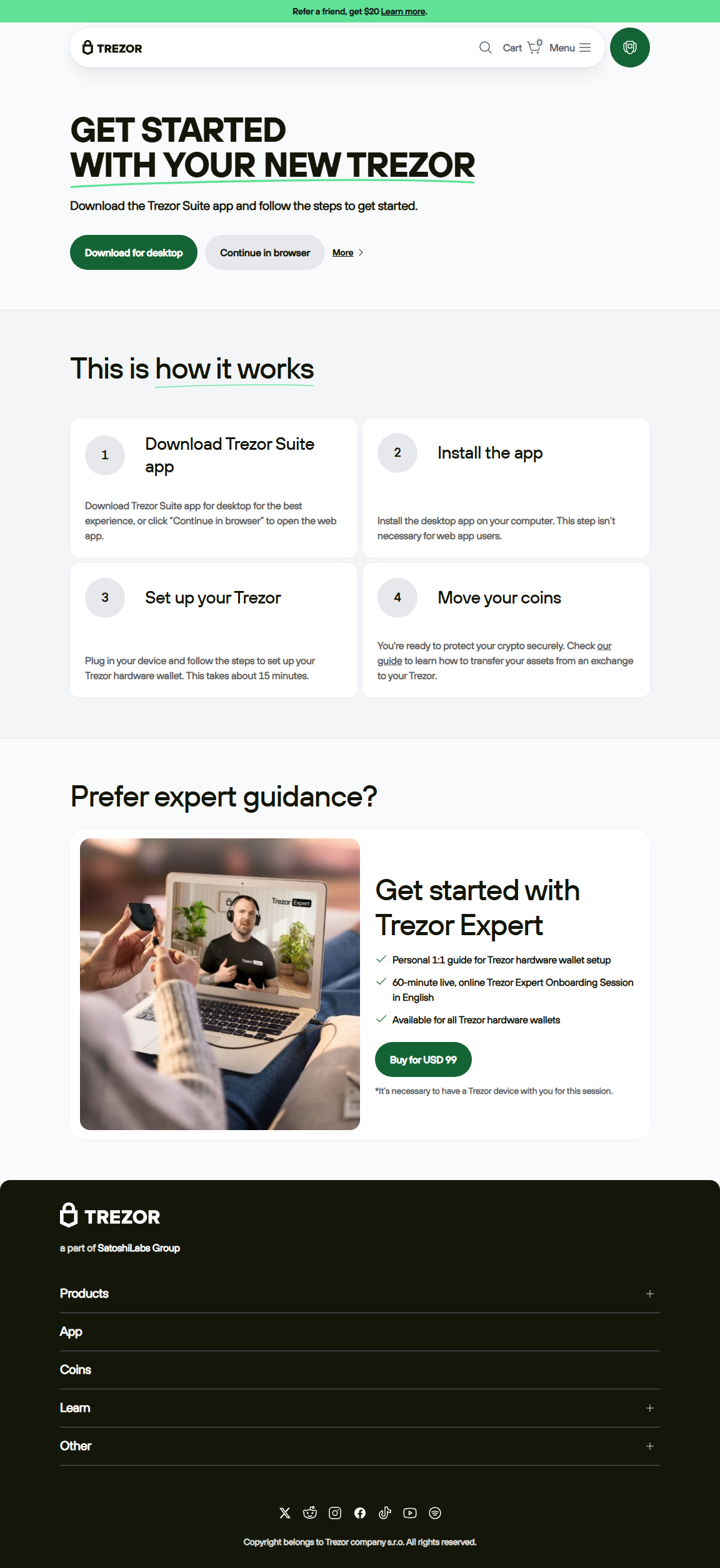Trezor.io/start — A Vibrant, Practical Guide to Setting Up & Mastering Your Trezor Wallet
Step-by-step onboarding, thoughtful security choices, and mid-level strategies for users who want real custody over their crypto — explained with clear examples, comparisons, and visual callouts.
Why start at Trezor.io/start?
If you own (or plan to buy) a Trezor hardware wallet, Trezor.io/start is the canonical, secure onboarding portal. It’s where you download Trezor Suite, verify firmware, and walk the device through seed generation and PIN setup. Think of it as the official handshake between your hardware and the internet — designed to keep private keys offline while letting you interact with blockchains safely.
A short story: Lena’s wake-up call
Lena bought her first Bitcoin in 2017 and left it on an exchange for convenience. In 2021 a phishing email led her to a fake support site; luckily the exchange froze withdrawals — but Lena realized she didn’t actually control her private keys. She switched to a Trezor, walked through Trezor.io/start, wrote her seed on metal, enabled a passphrase, and moved her holdings to a cold wallet. That small effort turned into years of peace of mind.
That’s what ownership looks like: small setup friction now, security that compounds later.
Step-by-Step: From Unbox to Secure — via Trezor.io/start
- Unbox and verify packaging. Check the holographic seal and that the device matches the model you ordered (Model One vs Model T). Don’t remove the seal until you’re ready to configure.
- Go to Trezor.io/start. This is the official onboarding page — type it manually or use a bookmark. Download Trezor Suite (desktop preferred for security).
- Connect your device and follow firmware prompts. The Suite will detect the device and suggest firmware updates — install them through the Suite, never via random downloads.
- Create a new wallet and write your seed. Trezor will generate a recovery seed phrase (12/18/24 words). Write it on the supplied card or a metal backup — never as a photo or plain text file.
- Set a PIN and (optionally) a passphrase. PIN protects access; a passphrase creates a hidden wallet (advanced, more on this later).
- Add accounts and start receiving funds. Use Trezor Suite to add Bitcoin, Ethereum, or other accounts and copy receiving addresses from the device (verify the address on-screen).
Trezor Model Snapshot
| Feature | Model One | Model T |
|---|---|---|
| Display | Monochrome OLED, 2 buttons | Full-color touchscreen |
| Supported coins | ~1000+ (core coins) | ~1600+ (more tokens & native apps) |
| Backup options | Standard seed phrase | Seed + Shamir Backup support |
| Price tier | Budget / Value | Premium / Feature-rich |
Model T is more future-proof and friendlier for beginners; Model One is a rugged, lower-cost choice for users who don’t need touchscreens or Shamir backups.
Mid-level moves: Passphrases, Shamir, and DeFi integrations
Passphrases — your “hidden” vault
A passphrase acts like a 25th word to your seed phrase. Use it to create hidden wallets that only appear when the correct passphrase is entered. This is powerful for plausible deniability and for separating funds (e.g., everyday spending vs. long-term cold storage).
Shamir Backup (Model T)
Shamir’s Secret Sharing splits your recovery into multiple shares. You distribute these shares (for example, 5 shares where any 3 restore) to geographically independent custodians or safes. That way, loss, theft, or damage to one share won’t result in permanent loss.
Using Trezor with DeFi & MetaMask
Trezor can sign transactions while your keys remain offline. Connect Trezor to MetaMask for seamless DeFi access (swaps, staking, NFTs) — the device signs messages and transactions, preventing direct exposure of private keys to the web app.
Key terms (woven into practice)
In this guide you encountered several foundational crypto terms: cold wallet (offline storage like Trezor), seed phrase (the human-readable recovery words), private key (the cryptographic secret that signs transactions), firmware (device software you must keep updated), DeFi (decentralized finance apps you can access via integrations), and ERC-20 (a common token standard on Ethereum supported via Trezor integrations).
FAQ — Practical answers
Q: Can I restore a Trezor seed on another brand?
A: Yes — recovery seeds follow BIP39/BIP44 standards. However, advanced features like passphrase-derived hidden wallets or Shamir shares may be incompatible across different vendors.
Q: Is it safe to type my seed into a computer if I trust it?
A: No. Typing your seed into a connected device risks exposure via malware or clipboard hijacking. Use Trezor Suite and a hardware device for all sensitive steps.
Q: How often should I check firmware updates?
A: Check monthly or follow the official channels for update alerts. Critical security patches should be applied as soon as possible through Trezor Suite.
Q: Can I use the same seed for multiple hidden wallets with different passphrases?
A: Yes — each unique passphrase generates a separate wallet derived from the same seed. Treat passphrases with the same confidentiality as the seed itself.
Security Checklist (sticky)
- Start only at Trezor.io/start.
- Verify firmware via Trezor Suite; update promptly.
- Write seed on multiple offline media (paper + metal).
- Use a PIN and consider a passphrase for hidden wallets.
- Test small transactions before moving large sums to DeFi.
- Store Shamir shares across trusted, geographically separated locations if used.
Conclusion — Ownership is a design choice
Trezor.io/start is not just a URL: it’s your first decision toward custody, resilience, and real digital ownership. For beginners, it turns an intimidating process into a clear checklist. For mid-level users, it’s the platform on which you build layered security — passphrases, Shamir backups, and careful DeFi interactions.
In practice: take thirty minutes to set up your device properly. Spend another hour creating and testing backups (metal plates, sealed envelopes with a lawyer or safe deposit box, distributed Shamir shares). These upfront hours are tiny compared to the years of protection they buy.
